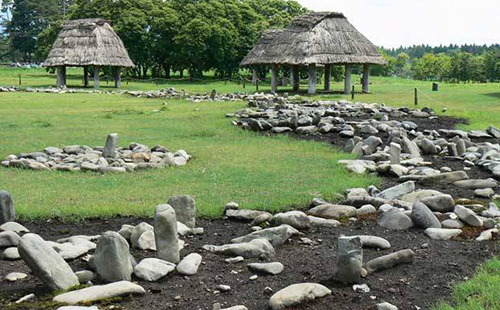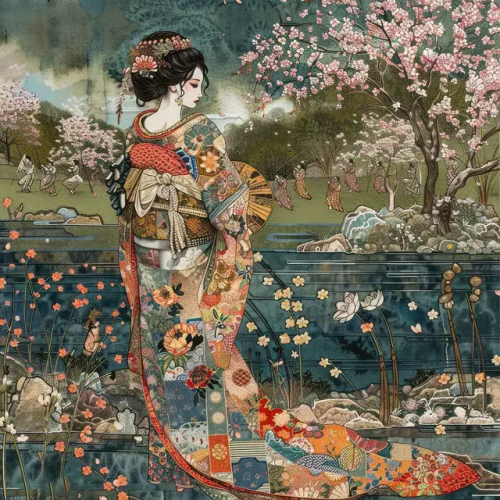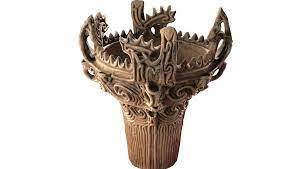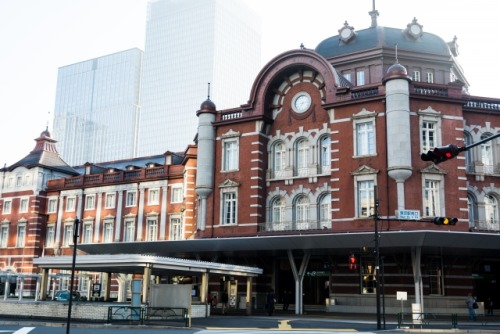旭日旗が流行しているので、それを最大限に利用するつもりだ。そして、彼らがそれを最大限に利用する方法を知っているのは、この話題だけではない。






Sean bienvenidos, japonsitasarqueologícos a una nueva entrega en la que hablaremos de un Trending Topic, ya que el país del sol naciente está de moda pues le vamos a sacar beneficios y no es el único tema que están sabiendo explotar, para sacarle el mayor partido. - Lo que vengo a referirme, es que las modas son puro negocio, de lo más nocivo que nos podemos llevar a la cara, antes de que Japón estuviera de moda ya había muchos fakes, pero ahora se han duplicado e incluso triplicado. No hay que creerse todo lo que leamos por internet, siempre hay que cuestionarse las cosas, en este caso vamos a sentarnos, en dos monumentos uno localizado en Inglaterra y otro en japón. - El primero, se trata de stonehenge: Construido en el cuarto mileno 3100 antes de nuestra era, que cada vez se actualizan sus funciones la última más reciente es que no puede ser usado como un calendario solar. El segundo, se trata de Isedōtai site, localizado en la prefectura de Akita, en la región de Tōhoku en el noroeste de Japón, construido en el quinto milenio 4000 a.c en el jomon final. Se usó como calendario solar y posiblemente para los solsticios de verano e invierno. - El tema de esta publicación no es hablar de ninguno de los dos en profundidad, sino criticar a los lucidos, que sitúan stonehenge y Isedōtai site en la misma recta cronológica lo cual es una falacia por que hay por lo menos 1100 a 1500 años de diferencia aproximadamente entre ambas construcciones. - Ese es el problema del occidentalismo y eurocentrismo sobre todo la manía de colocarlo todo en una recta cronológica las fechas son algo aproximadas al igual que las rectas temporales. - Espero que os haya gustado y nos vemos en próximas publicaciones que pasen una buena semana.
Welcome, japonsitasarchaeologists, to a new edition in which we will talk about a Trending Topic, since the country of the rising sun is in fashion, we are going to make the most of it and it is not the only topic that they are knowing how to exploit, to make the most of it. - What I am referring to is that fashions are pure business, the most harmful thing we can take to our faces. Before Japan was in fashion there were already many fakes, but now they have doubled and even tripled. We should not believe everything we read on the internet, we should always question things, in this case we are going to sit on two monuments, one located in England and the other in Japan. - The first one is stonehenge: Built in the fourth millennium 3100 B.C., its functions are updated every time, the latest one is that it cannot be used as a solar calendar. The second is the Isedōtai site, located in Akita prefecture, in the Tōhoku region of northwestern Japan, built in the fifth millennium 4000 BC in the final jomon. It was used as a solar calendar and possibly for the summer and winter solstices. - The subject of this publication is not to discuss either in depth, but to criticise the lucid, who place stonehenge and Isedōtai site in the same chronological line which is a fallacy because there is at least 1100 to 1500 years difference approximately between the two constructions. - That is the problem of westernism and eurocentrism, especially the mania of placing everything on a chronological line, the dates are somewhat approximate, as are the time lines. - I hope you liked it and see you in future publications. Have a nice week.
旭日旗が流行しているので、それを最大限に利用するつもりだ。そして、彼らがそれを最大限に利用する方法を知っているのは、この話題だけではない。
私が言いたいのは、ファッションは純粋なビジネスであり、最も有害なものであるということだ。 日本が流行する前からすでに多くの偽物があったが、今では倍増し、3倍にもなっている。インターネット上の情報を鵜呑みにするのではなく、常に物事を疑ってみる必要がある。
ひとつはストーンヘンジで、紀元前3100年の第四千年紀に建てられた。 もうひとつは、東北地方の秋田県にある伊勢堂岱遺跡で、紀元前4000年、縄文末期の第5千年紀に作られた。
太陽暦として使われ、おそらく夏至と冬至にも使われた。
本書の主題は、どちらか一方を深く論じることではなく、ストーンヘンジと伊勢堂岱遺跡を同じ年代線上に置く明晰な人々を批判することである。
それが西洋主義とヨーロッパ中心主義の問題点であり、特にあらゆるものを年代順に並べようとするマニアの問題点である。
お気に召していただけたなら幸いである。 それではまた。
More Posts from Noticiasarquelogicasjaponesas and Others




Sean bienvenidos amantes del mundo japonés a una nueva publicación, en esta ocasión vamos a hablar sobre el kimono y su historia. Una vez dicho esto, pónganse cómodos que comenzamos. - Antes que nada, ¿Qué significa la palabra kimono? Está compuesto por dos kanjis: 着. El primer kanji es el que hace referencia al llegar y vestir, que en japonés sería つく, 物 y el segundo kanji está compuesto por una palabra que significa mono, es decir cosa, y si lo traducimos literalmente, sería cosa para vestir. La historia del kimono se remonta al siglo VIII después de Cristo durante el periodo Heian (794-1192), sobre todo era una vestimenta de seda y de una serie de materiales que se lo podían permitir la aristocracia y la gente de alta cuna. - Espero que os haya gustado y nos vemos en próximas publicaciones del mundo japonés hasta la próxima. - Welcome lovers of the Japanese world to a new publication, this time we are going to talk about the kimono and its history. Having said that, make yourselves comfortable and let's get started. - First of all, what does the word kimono mean? It is made up of two kanji: 着. The first kanji is the one that refers to arriving and dressing, which in Japanese would be つく, 物 and the second kanji is composed by a word that means monkey, that is to say thing, and if we translate it literally, it would be a thing to wear. The history of the kimono dates back to the 8th century AD during the Heian period (794-1192), it was mainly a garment made of silk and a series of materials that could be afforded by the aristocracy and people of high birth. - I hope you liked it and see you in future publications of the Japanese world until the next one. - 今回は着物とその歴史についてお話しします。それでは、くつろいでいただき、始めましょう。 - まず、着物とはどういう意味でしょうか?着物は2つの漢字からできています。つ目の漢字は「着」、日本語では「物」、2つ目の漢字は「猿」、つまり「物」、直訳すれば「着る物」である。着物の歴史は西暦8世紀、平安時代(794-1192)にまで遡り、主に絹や一連の素材で作られた衣服で、貴族や身分の高い人々が手に入れることができるものでした。 - お気に召していただけたなら幸いである。次回の出版まで、日本の世界の今後の出版物でお会いしよう。




Introducción a la cerámica Jōmon: - Tipos cerámica Jōmon se dividen en 5 : 1 fukabachi 2 hachi 3 asabachi 4 tsubo 5 chuko - ¿Cónocian algúnos de estos tipos? os deseo un feliz día un cordial saludo. - Introduction to Jōmon Pottery: - Jōmon ceramic types are divided into 5: 1 fukabachi 2 hachi 3 asabachi 4 tsubo 5 chuko - Do you know any of these guys? I wish you a happy day, a cordial greeting. - 縄文土器の紹介: - 縄文土器は次の5種類に分類されます。 深鉢 1個 2ハチ 3アサバチ 4坪 5中子 - この人たちを知っている人はいますか? 幸せな 一日をお祈りします。心からのご挨拶を申し上げます。
Primeras fotos Machiya:




SEGUDA FOTO : Entrada a un Onsen.


COMO EJEMPLO :

Sean bienvenidos, japonistas arqueológicos, a una nueva entrega en este blog sobre temática japonesa en general. Una vez dicho esto, pónganse cómodos, que comenzamos.
-
El año pasado, indagando por Tumblr, me encontré una cuenta en la que compartía la imagen que veréis como ejemplo después de los onsen, porque esta cuenta, que la mantendré en anonimato, no sé con qué objetivo lo hizo, si fue mero entretenimiento o que se confundió, porque puso la foto que veréis como ejemplo de terma romana, un manga con el símbolo de los onsen (おんせん), y lo puso con una calle de fondo típica tradicional del periodo Edo, donde aparecían las llamadas machiya (まちや), que son casas de comerciantes, artesanos, con su peculiar símbolo sugidama (すぎだま), que representa el sake, es decir, cuando se puede recoger, ya que el sake ha madurado y se puede beber.
-
He querido hacer esta publicación no a modo de crítica, sino a modo de aclaración, porque como no sé con el objetivo que lo hizo, pues me gustaría aclarar con esta publicación lo que realmente es un onsen, que son lugares de aguas termales ♨️, y que pueden estar al aire libre y los hay de muchos tipos.
-
Espero que os haya gustado. Espero que paséis una muy buena semana y nos vemos en próximas publicaciones. Hasta la próxima.
-
ようこそ、考古学的日本愛好家の皆さん、日本をテーマにしたこのブログの新しい回へ。とはいえ、くつろいでください。 というのも、このアカウントは匿名にしておくが、どういう目的でこのようなことをしたのか、単なる娯楽だったのか、それとも混乱してしまったのかは分からない、 江戸時代の典型的な伝統的な町並みの背景には、いわゆる町家(商人や職人の家)があり、独特のシンボルである「杉玉(すぎだま)」は酒を表している。
-
私はこの出版物を批評としてではなく、明確化として作りたかった。というのも、私はこの出版物を作った目的を知らないので、この出版物によって、温泉とは本当は何なのかを明らかにしたいと思う。温泉の場所は♨️、屋外にあり、多くの種類がある。-お気に召していただけたなら幸いです。それでは、今週も良い一週間をお過ごしください。それではまた次回。
-
Welcome, archaeological Japanophiles, to a new instalment in this general Japanese-themed blog. That being said, make yourselves comfortable, we're getting started. Last year, digging through Tumblr, I came across an account that shared the image you will see as an example after the onsen, because this account, which I will keep anonymous, I don't know with what purpose it did it, if it was mere entertainment or that it got confused, because it put the picture you will see as an example of a Roman bath, a manga with the symbol of the onsen (おんせん), and put it with a typical traditional background street of the Edo period, where appeared the so-called machiya (まちや), which are houses of merchants, artisans, with its peculiar symbol sugidama (すぎだま), which represents the sake, that is, when you can collect, since the sake has matured and can be drunk. -I wanted to make this publication not as a criticism, but as a clarification, because as I do not know with the objective that made it, I would like to clarify with this publication what really is an onsen, which are places of hot springs ♨️, and that can be outdoors and there are many types. -I hope you liked it. I hope you have a great week and see you in future posts. See you next time.


Sean bienvenidos japonistasarqueológicos en esta ocasión no os traigo una noticia de arqueología, hoy dia 8 de julio de 2022 no ha llegado la terrible noticia de que el ex primer ministro Abe fue asesinado en un atentado en la ciudad de Nara por un ex soldado de la marina de autodefensa. Antes que nada me gustaría aclarar que esta publicación no es apta para todo los públicos, ya que puede herir la sensibilidad del espectador dicho esto empezamos.
-
¿Quién es Abe Shinzō?, fue Primer ministro (2006-2007, 2012-2020) Nació en Nagano, prefectura de Yamaguchi, región de Chugoku, 21 septiembre 1954. Perteneció al partido Liberal Democrático (Jiminto) y desempeñó la profesión de politólogo.
-
Al Sr. Yamagami es despreciable, no se le puede considerar patriótico, tiene la mentalidad fría hay que tener las agallas para realizar dicho acto de salvajismo en pleno acto público eso sí que es caer bajo además de crear una escopeta casera para asesinarlo. Los motivos que le llevó a realizarlo fue por estar en desacuerdo, el mundo está lleno de imperfecciones y no se debe matar a nadie por estar en desacuerdo, espero que le condenen con la máxima crueldad posible.
-
Mis más sincero pésame, para japón y los japoneses por esta tragedia que se podía haber evitado yo también estoy conmovido por lo ocurrido. Os deseo una feliz semana y nos vemos en próximas publicaciones de historia, arqueología, geografía y antropología de japón.
-
考古学の日本人は歓迎します、この機会に私はあなたに考古学のニュースをお届けしません、今日、2022年7月8日、元首相が奈良市で元兵士による攻撃で暗殺されたという恐ろしいニュースは到着していません-防衛海軍。まず、この出版物は視聴者の感性を損なう可能性があるため、すべての視聴者に適しているわけではないことを明確にしておきたいと思います。
-
安倍信三とは?首相(2006-2007、2012-2020)1954年9月21日中口県山口県長野生まれ。自由民主党(じみんと)に所属し、政治家として活躍。科学者。
-
山上さんは卑劣で、愛国心が強いとは言えず、冷淡な精神を持っており、公の場で野蛮な行為を行うには勇気が必要です。彼を暗殺するショットガン。彼がそれをやった理由は、彼が反対したからであり、世界は不完全さでいっぱいであり、反対したことで誰も殺されるべきではありません。彼らが彼を可能な限りの残酷さで非難することを願っています。
-
避けられたはずのこの悲劇について、日本と日本人に心からお悔やみ申し上げます。また、起こったことにも感動しました。皆様のご多幸をお祈り申し上げますとともに、日本の歴史、考古学、地理学、人類学の今後の出版物でお会いしましょう。
-
Archaeological Japaneseists welcome, on this occasion I do not bring you archeology news, today, July 8, 2022, the terrible news has not arrived that former Prime Minister Abe was assassinated in an attack in the city of Nara by a former soldier of the self-defense navy. First of all, I would like to clarify that this publication is not suitable for all audiences, since it can hurt the sensitivity of the viewer, having said this, we begin.
-
Who is Abe Shinzō? He was Prime Minister (2006-2007, 2012-2020) He was born in Nagano, Yamaguchi prefecture, Chugoku region, September 21, 1954. He belonged to the Liberal Democratic Party (Jiminto) and worked as a political scientist.
-
Mr. Yamagami is despicable, he cannot be considered patriotic, he has a cold mentality, you have to have the guts to carry out such an act of savagery in the middle of a public act, that is falling low in addition to creating a homemade shotgun to assassinate him. The reasons that led him to do it was because he disagreed, the world is full of imperfections and no one should be killed for disagreeing, I hope they condemn him with the maximum cruelty possible.

コストコ予定地で「遺構を一般公開せず埋めた」報道 市教委「法律違反かの印象与える記事は心外」...朝日新聞の見解は
-


Report on 'remains buried without public access' at planned Costco site, City Board of Education: 'It is disturbing to read an article that gives the impression that it is against the law…'… What is the Asahi Shimbun's view?

HISTORIA DE LA ARQUEOLOGÍA JAPONESA Y EL PENSAMIENTO CIENTÍFICO.
Capítulo 1: Sean bienvenidos, japonistasarqueológicos, a una nueva entrega de arqueología nipona, vista desde un punto de vista filosófico, una vez dicho esto pónganse cómodos qué empezamos. — Seguramente, todos nos hacemos las mismas preguntas cuando se nos pregunta determinados temas de historia y de arqueología. ¿Quiénes eran nuestros antepasados y por qué llegaron a este determinado lugar y no a x? ¿De qué medios disponían para lograr determinadas hazañas históricas? En nuestro caso nos centraremos en dos preguntas determinadas ¿Quiénes fueron los primeros pobladores del archipiélago japonés? Y de ver cómo dicha idea ha llegado a nuestros días sin una respuesta clara, ya que tanto arqueólogos, historiadores, antropólogos, entre otros, han intentado dar una posible respuesta a una de las mayores incógnitas de la historia de la arqueología japonesa. — ¿Cuándo surgió la arqueología japonesa propiamente dicha? La historia de Japón es un tanto complicada, debido a que la ciencia propiamente dicha no nace hasta finales del siglo XIX, para ser más exactos 12 de abril 1877 ¿Cuándo surgen las sociedades arqueológicas, antropológicas y el laboratorio de antropología en Tokio? Además, tuvieron mucha influencia de gente tanto de Europa como de Estados Unidos, ya que tenían una gran influencia para aquel momento y mencionaremos algunos y a uno de los arqueólogos más destacados del mundo japonés. — ¿Cuándo surgen las sociedades arqueológicas, antropológicas y el laboratorio de antropología en Tokio? Para responder a dicha pregunta: A partir de 1880,vino un proceso gradual de institucionalización a la arqueología, generando un nuevo marco académico y universitario: Dando lugar al nacimiento de la Sociedad Antropológica de Tōkyō 1884, se creó el Laboratorio de Antropología en la Universidad de Tōkyō 1888,la fundación de la Sociedad Arqueológica se fundó en Japón en 1895. — Espero que os haya gustado y nos vemos en próximas publicaciones que pasen una buena semana.
HISTORY OF JAPANESE ARCHEOLOGY AND SCIENTIFIC THOUGHT.
Chapter 1: Welcome, Japanesearchaeologicalists, to a new installment of Japanese archaeology, seen from a philosophical point of view. Having said that, get comfortable and let's begin. — Surely, we all ask ourselves the same questions when we are asked certain topics in history and archeology. Who were our ancestors and why did they arrive at this certain place and not x? What means did they have to achieve certain historical feats? In our case we will focus on two specific questions: Who were the first settlers of the Japanese archipelago? And to see how this idea has reached our days without a clear answer, since archaeologists, historians, anthropologists, among others, have tried to give a possible answer to one of the biggest unknowns in the history of Japanese archaeology. — When did Japanese archeology itself emerge? The history of Japan is somewhat complicated, because science itself was not born until the end of the 19th century, to be more exact April 12, 1877 When did the archaeological and anthropological societies and the anthropology laboratory emerge in Tokyo? In addition, they had a lot of influence from people from both Europe and the United States, since they had a great influence at that time and we will mention some of them and one of the most prominent archaeologists in the Japanese world. — When did the archaeological and anthropological societies and the anthropology laboratory emerge in Tokyo? To answer this question: Starting in 1880, a gradual process of institutionalization of archeology came, generating a new academic and university framework: Giving rise to the birth of the Tōkyō Anthropological Society 1884, the Anthropology Laboratory was created at the University from Tōkyō 1888, the foundation of the Archaeological Society was founded in Japan in 1895. — I hope you liked it and see you in future posts, have a good week.
日本の考古学と科学思想の歴史。
第1章: 日本の考古学者の皆さん、哲学的観点から見た新しい日本考古学へようこそ。 — 確かに、歴史や考古学の特定のトピックを尋ねられたとき、私たちは皆同じ質問をするでしょう。 私たちの祖先は誰でしたか、そしてなぜ彼らは x ではなくこの特定の場所に到着したのでしょうか? 彼らは特定の歴史的偉業を達成するためにどのような手段を必要としたのでしょうか? 私たちの場合は、2 つの具体的な質問に焦点を当てます。日本列島の最初の入植者は誰ですか? そして、考古学者、歴史家、人類学者などが、日本の考古学史上最大の未知の一つに可能な答えを与えようとして以来、この考えが明確な答えがないまま、どのようにして現代に至ったのかを見てみましょう。 — 日本の考古学自体はいつ頃から生まれたのでしょうか? 日本の歴史はやや複雑です。科学そのものが誕生したのは 19 世紀末、より正確には 1877 年 4 月 12 日です。考古学人類学協会と人類学研究所が東京に誕生したのはいつですか? さらに、彼らは当時大きな影響力を持っていたため、ヨーロッパとアメリカの両方の人々から多くの影響を受けていました。彼らの一部と日本の世界で最も著名な考古学者の一人についても言及します。 — 東京に考古人類学会や人類学研究室が誕生したのはいつですか? この質問に答えるには、1880 年から考古学の制度化が段階的に進み、新しい学問と大学の枠組みが生まれました。1884 年に東京人類学会が誕生し、1888 年に東京で人類学研究室が大学に設立されました。考古学協会の財団は 1895 年に日本で設立されました。 — 気に入っていただければ幸いです。今後の投稿でお会いしましょう。良い一週間をお過ごしください






Sean bienvenidos japonistasarqueológicos, a una nueva entrega de arqueología japonesa, una vez dicho esto pónganse cómodos que empezamos. - Hoy nos trasladamos a las ruinas que se localizan, en la ciudad de Sagamihara, se localiza en la prefectura de Kanagawa, su situación geográfica es la región de Kanto ¿De qué periodo se trata? Se trata del período Jomon, este período estaría dentro del paleolítico. - Las primeras intervenciones arqueológicas se realizaron en 1973 para la construcción de la Ruta 129, se levantaron aproximadamente 18.000 metros cuadrados en el lado este del asentamiento circular, en dicho yacimiento se han descubierto 51 nuevas viviendas en pozos y otros restos y reliquias. - En el emplazamiento se han descubierto 51 nuevas viviendas en pozos y otros restos y reliquias, la vivienda de pozo más grande de la ciudad con un diámetro de 9 m, hay una vivienda con muchas capas de ranuras alrededor del perímetro, y se explica que ha sido reconstruida y utilizada durante varias generaciones. - 日本の考古学者たちよ、ようこそ。そう言われたら、くつろいで、さっそく始めましょう。 - 今日は神奈川県相模原市にある遺跡を紹介します。 時代は?縄文時代です。この時代は旧石器時代にあたります。 - 1973年に国道129号線建設のために初めて考古学的発掘調査が行われ、円形集落の東側で約18,000平方メートルが発掘された。遺跡からは、ピット内の51の新しい住居やその他の遺跡や遺物が発見された。 - 敷地内では新たに51基の竪穴式住居やその他の遺跡・遺物が発見され、市内最大の直径9mの竪穴式住居には、周囲に何層もの溝を持つ住居があり、数世代にわたって改築・使用されてきたことが説明されています。 - 気に入っていただけたなら幸いです。今後の記事でお会いしましょう。良い一週間をお過ごしください。 -
Welcome to Japanesearchaeology, to a new installment of Japanese archaeology. Having said that, make yourself comfortable and let's begin.
-
Today we move to the ruins that are located in the city of Sagamihara, located in the Kanagawa prefecture, its geographical location is the Kanto region. What period is it? This is the Jomon period, this period would be within the Paleolithic.
-
The first archaeological interventions were carried out in 1973 for the construction of Route 129, approximately 18,000 square meters were built on the east side of the circular settlement, at this site 51 new homes have been discovered in wells and other remains and relics.
- 51 new well dwellings and other remains and relics have been discovered at the site, the largest well dwelling in the city with a diameter of 9 m, there is a dwelling with many layers of grooves around the perimeter, and it is explained that it has been rebuilt and used for several generations.




Sean bienvenidos japonistasarqueologícos a una nueva entrega para finalizar el Obon se realizan los llamados Gozan no Okuribi, tambien conocido como Daimonji se realizan el día 16 de agosto. - Espero que os guste y nos vemos en próximas publicaciones, que pasen una buena semana. - Welcome Japanese archaeologists to a new installment to end the Obon, the so-called Gozan no Okuribi, also known as Daimonji, are held on August 16. - I hope you like it and see you in future publications, have a good week. - 日本の考古学者の皆さん、お盆の締めくくりとなる新たな行事、いわゆる五山の送り火(大文字としても知られています)が 8 月 16 日に開催されます。 - 気に入っていただければ幸いです。今後の出版物でお会いできることを願っています。良い一週間をお過ごしください。 -




Sean bienvenidos japonistasarqueológicos, a una nueva entrega en la cual hablaremos de la famosa estación de Tokyo, uno de los pocos edificios que ha sobrevivido al paso del tiempo, ya que tras la operación doolittle y el gran terremoto de Tokio de 1923, Tokio ha sido muy remodelada, dicho esto pónganse cómodos que empezamos. - En 1908, comenzó su construcción en lo que respecta a la estación central, en 1914 empezó a funcionar, en la era Taisho 1915 Se inauguró el hotel de la estación de Tokio. En el año 1923 tiene lugar el Gran Terremoto de Kanto y el edificio de la estación no está particularmente dañado, se pudo reparar, pero la ciudad de Tokyo fue remodelada por completo y en 2007 realizaron trabajos de restauración, terminado en 2012. Hay que recordar que ha sufrido muchas restauraciones, ya que la de 1945 fue la más letal de todas. - Espero que os haya gustado y nos vemos en próximas publicaciones ¿Conocían este edificio y su historia? Que pasen una buena semana. - 今回は、有名な東京駅についてお話します。ドゥーリトル作戦や1923年の東京大震災の後、東京は大きく改造されましたが、その中でも数少ない時代の流れに耐えた建物の一つです。 - 1908年、中央駅の建設が始まり、1914年に開業、大正時代の1915年には東京ステーションホテルがオープンしました。1923年に関東大震災が起こり、駅舎は特に被害はなく、修復されましたが、東京の街は完全に改造され、2007年に修復工事が行われ、2012年に完成しました。1945年の震災が最も致命的であったため、何度も修復が行われたことを忘れてはならない。 - この建物とその歴史を知っていましたか?それでは、今週もよろしくお願いします。 - Welcome to a new installment in which we will talk about the famous Tokyo Station, one of the few buildings that has survived the passage of time, since after operation doolittle and the great Tokyo earthquake of 1923, Tokyo has been greatly remodelled, that said, make yourselves comfortable and let's get started. - In 1908, construction began on the Central Station, which became operational in 1914, and in the Taisho era 1915, the Tokyo Station Hotel was opened. In 1923 the Great Kanto Earthquake took place and the station building was not particularly damaged, it was repaired, but the city of Tokyo was completely remodelled and in 2007 restoration work was carried out, completed in 2012. It should be remembered that it has undergone many restorations, as the one in 1945 was the most lethal of them all. - I hope you liked it and see you in future posts. Did you know this building and its history? Have a nice week.
-
 bear-pattern-hamster liked this · 10 months ago
bear-pattern-hamster liked this · 10 months ago -
 repera23 liked this · 10 months ago
repera23 liked this · 10 months ago -
 jlmahmud liked this · 1 year ago
jlmahmud liked this · 1 year ago -
 praline1968 liked this · 1 year ago
praline1968 liked this · 1 year ago -
 dutchs-blog liked this · 1 year ago
dutchs-blog liked this · 1 year ago -
 babylon-iraq-baghdad liked this · 1 year ago
babylon-iraq-baghdad liked this · 1 year ago -
 hcr-den liked this · 1 year ago
hcr-den liked this · 1 year ago -
 nekogamenya liked this · 1 year ago
nekogamenya liked this · 1 year ago -
 rodolfo9999 liked this · 1 year ago
rodolfo9999 liked this · 1 year ago -
 gerda-p liked this · 1 year ago
gerda-p liked this · 1 year ago -
 meteoriteslunar liked this · 1 year ago
meteoriteslunar liked this · 1 year ago -
 misterio-m liked this · 1 year ago
misterio-m liked this · 1 year ago -
 dgfmaurizio liked this · 1 year ago
dgfmaurizio liked this · 1 year ago -
 noseysilverfox liked this · 1 year ago
noseysilverfox liked this · 1 year ago -
 waiting-eyez liked this · 1 year ago
waiting-eyez liked this · 1 year ago -
 aquagradient liked this · 1 year ago
aquagradient liked this · 1 year ago -
 marysmirages liked this · 1 year ago
marysmirages liked this · 1 year ago -
 ted-blogs-blog liked this · 1 year ago
ted-blogs-blog liked this · 1 year ago -
 kseenefrega liked this · 1 year ago
kseenefrega liked this · 1 year ago -
 vivencias-del-alma liked this · 1 year ago
vivencias-del-alma liked this · 1 year ago -
 narihira8 liked this · 1 year ago
narihira8 liked this · 1 year ago -
 loneviatoris reblogged this · 1 year ago
loneviatoris reblogged this · 1 year ago -
 hiromusicarts-blog liked this · 1 year ago
hiromusicarts-blog liked this · 1 year ago -
 sicks93 liked this · 1 year ago
sicks93 liked this · 1 year ago -
 noticiasarquelogicasjaponesas reblogged this · 1 year ago
noticiasarquelogicasjaponesas reblogged this · 1 year ago

238 posts







